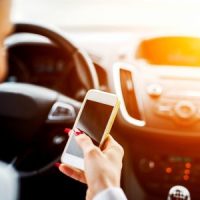5 Types of Evidence to Help You Prove Distracted Driving

Distracted driving is a prevalent issue that affects many individuals on the roadways. Did you know that distracted driving killed over 3,500 people in 2021, according to the National Highway Traffic Safety Administration (NHTSA)?
If you are involved in an accident caused by a distracted driver, it can be difficult to prove that their attention was diverted at the time of the crash. Fortunately, there are specific types of evidence that can help you provide compelling evidence in your case. Our Baltimore attorneys at Berman | Sobin | Gross LLP can help you prove your case and pursue the compensation you deserve.
What Evidence Do You Need to Prove the Other Driver Was Distracted?
There are several pieces of evidence that can help you prove the other driver was distracted when your accident occurred:
1. Eyewitness Statements
Eyewitness accounts are an effective way to prove distracted driving. If any witnesses were present at the time of the car accident, they can offer an impartial account of what happened and any observed instances of distracted driving. Their testimonies can provide critical evidence to support your case and establish the other driver’s negligence. Be sure to gather as much information, including full names, contact details, and an account of their experience.
2. Cell Phone Data and Records
In many cases, distracted driving is often caused by mobile phones. Records of phone calls, text messages, social media notifications, and GPS routes can be compelling evidence in proving distracted driving. Phone records can help determine the timeframe in which the accident occurred and whether the driver was using their phone. These records can help establish negligence and may sway a court’s judgment regarding the fault.
3. Surveillance Footage
Surveillance footage is often readily available in most parts of the country. If the accident occurred in a commercial or residential area, the surrounding business may have cameras that recorded the event. Review the footage for any signs of distracted driving, such as texting, dialing, or browsing the phone while behind the wheel. This type of footage is undoubtedly crucial and can provide irrefutable evidence that even the driver’s attorney or insurance company cannot refute.
4. Crash Reconstruction
Accident reconstruction is another powerful way to prove distracted driving. Crash reconstruction specialists can use physical evidence at the scene, like tire marks, impact points, and vehicle shape changes, to recreate the accident. They analyze all the evidence to determine how the accident happened and what the drivers were doing before and during the accident.
5. Police Report
The police report is a vital piece of evidence in any car accident case. A police report documents any injuries, damages, and the cause of the accident based on their investigation at the scene. They can also document any signs or evidence of distracted driving they observed. It is essential to obtain a copy of the police report before proceeding with your case. This is the quickest and easiest way to gain critical information to strengthen your case.
Let Us Help You Prove Your Case
Proving distracted driving is never easy unless the driver admits to being distracted. It requires gathering a substantial amount of evidence to prove that the other driver’s attention was diverted at the time of the crash.
But by utilizing the five types of evidence presented above, you can create a compelling case and win your claim. Our attorneys at Berman | Sobin | Gross LLP can help you gather all available pieces of evidence to prove your claim. Call 800-248-3352 for a free case evaluation.
Source:
nhtsa.gov/risky-driving/distracted-driving
